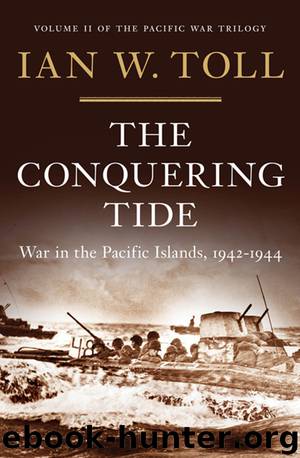The Conquering Tide by Ian W. Toll

Author:Ian W. Toll [Toll, Ian W.]
Language: eng
Format: epub
ISBN: 9780393248203
Publisher: W. W. Norton & Company
Published: 0101-01-01T00:00:00+00:00
TWO PARALLEL PACIFIC CAMPAIGNS, north and south of the equator, now had the imprimatur of the Allied high command. But Nimitz did not yet possess the sea or carrier air forces needed to wage a central Pacific offensive, and the troops in his theater required months of additional amphibious training. From his South Pacific headquarters, Halsey was calling for reinforcements to carry his fight into the central Solomons. Nonetheless, King wanted hard deadlines for the central Pacific campaign. “In order that effective momentum of offensive operations can be attained and maintained,” he told his fellow chiefs on June 10, “firm timing must be set up for all areas.”61 Four days later, the Joint Chiefs of Staff instructed Nimitz to prepare to invade the Marshall Islands with a tentative sailing date of November 15, 1943. MacArthur was to release the 1st Marine Division in time to participate in the operation, and most of Halsey’s naval and amphibious forces would be shifted to Pearl Harbor as well. With unusual candor the chiefs acknowledged that the date was somewhat arbitrary—but in the absence of deadlines “it is not repeat not practicable to provide able structure for our operations throughout the Pacific and Far East.”62
Predictably outraged, MacArthur objected that the demands of his CARTWHEEL campaign precluded any transfers of troops or ships from his theater to Nimitz’s. Indeed, MacArthur wanted (and would receive) covering support from the Pacific Fleet’s new fast carrier task forces in raids against Rabaul, Truk, and other Japanese bases on the southern route. Likewise, Halsey was anxious about the withdrawal of aircraft from the SOPAC region for support of operations north of the equator. Diverting airpower from the drive on Rabaul, he warned Nimitz on June 25, “would seriously jeopardize our chances of success at what appears to be the most critical stage of the campaign.”63
Without borrowing forces from the South Pacific, Nimitz could not realistically tackle the Marshalls until early 1944, and some on the CINCPAC planning staff counseled patience. They argued, not unreasonably, that the new offensive should await the arrival of a large fleet of Essex carriers, which could spearhead long leaps across ocean wastes and beat back enemy land-based air attacks. By February or March 1944, a much-expanded Fifth Fleet could simply steam into the Marshalls and seize the four or five largest Japanese bases in the group simultaneously. If the Japanese fleet came out to fight, the fast carrier task forces would willingly and confidently give battle.
But King wanted action in 1943. He insisted that the northern line of attack be opened before the final assault on Rabaul, so that the enemy could not concentrate his defenses against either prong of the westward advance. Enemy territory had to be taken, somewhere in the central Pacific, before the end of the year. Two competing suggestions were debated at CINCPAC headquarters. Captain Forrest P. Sherman, the influential chief of staff to Vice Admiral John Henry Towers (Commander Air Forces, Pacific, or “COMAIRPAC”), circulated a plan to recapture
Download
This site does not store any files on its server. We only index and link to content provided by other sites. Please contact the content providers to delete copyright contents if any and email us, we'll remove relevant links or contents immediately.
| Central Asia | Southeast Asia |
| China | Hong Kong |
| India | Japan |
| Korea | Pakistan |
| Philippines | Russia |
The Sympathizer by Viet Thanh Nguyen(4343)
The Rape of Nanking by Iris Chang(4169)
World without end by Ken Follett(3446)
Ants Among Elephants by Sujatha Gidla(3442)
Blood and Sand by Alex Von Tunzelmann(3167)
Japanese Design by Patricia J. Graham(3139)
The Queen of Nothing by Holly Black(2545)
City of Djinns: a year in Delhi by William Dalrymple(2533)
Foreign Devils on the Silk Road: The Search for the Lost Treasures of Central Asia by Peter Hopkirk(2444)
India's Ancient Past by R.S. Sharma(2433)
Inglorious Empire by Shashi Tharoor(2413)
Tokyo by Rob Goss(2407)
In Order to Live: A North Korean Girl's Journey to Freedom by Yeonmi Park(2361)
Tokyo Geek's Guide: Manga, Anime, Gaming, Cosplay, Toys, Idols & More - The Ultimate Guide to Japan's Otaku Culture by Simone Gianni(2346)
India's biggest cover-up by Dhar Anuj(2336)
The Great Game: On Secret Service in High Asia by Peter Hopkirk(2318)
Goodbye Madame Butterfly(2229)
Batik by Rudolf Smend(2153)
Living Silence in Burma by Christina Fink(2049)
